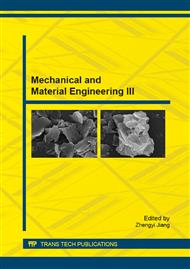p.71
p.75
p.79
p.83
p.88
p.92
p.96
p.100
p.105
Effects of Annealing Temperature on Resistance Switching Properties of ZnMn2O4 Films Deposited by Magnetron Sputtering
Abstract:
ZnMn2O4 films were fabricated on p-Si substrate by magnetron sputtering. The effects of annealing temperature on microstructure, resistance switching properties and endurance characteristics of ZnMn2O4 films were investigated. The ZnMn2O4 films with a structure of Ag/ZnMn2O4/p-Si exhibit bipolar resistive switching behavior. The results indicated that the annealing temperature has not changed its spinel structure, the bipolar resistance behavior and endurance characteristics, but the grain become more and more large, arranged closed and distributed evenly with the increase of annealing temperature from 450°C to 750°C. The ZnMn2O4 films annealed at 600°C have the biggest RHRS/RLRS ratio, the lowest VON and VOFF. The RHRS/RLRS ratios of all specimens maintain at about 103 after successive 1000 switching cycles, which indicated that the Ag/ZnMn2O4/p-Si device has better endurance characteristics.
Info:
Periodical:
Pages:
88-91
Citation:
Online since:
July 2015
Authors:
Price:
Сopyright:
© 2015 Trans Tech Publications Ltd. All Rights Reserved
Share:
Citation:


